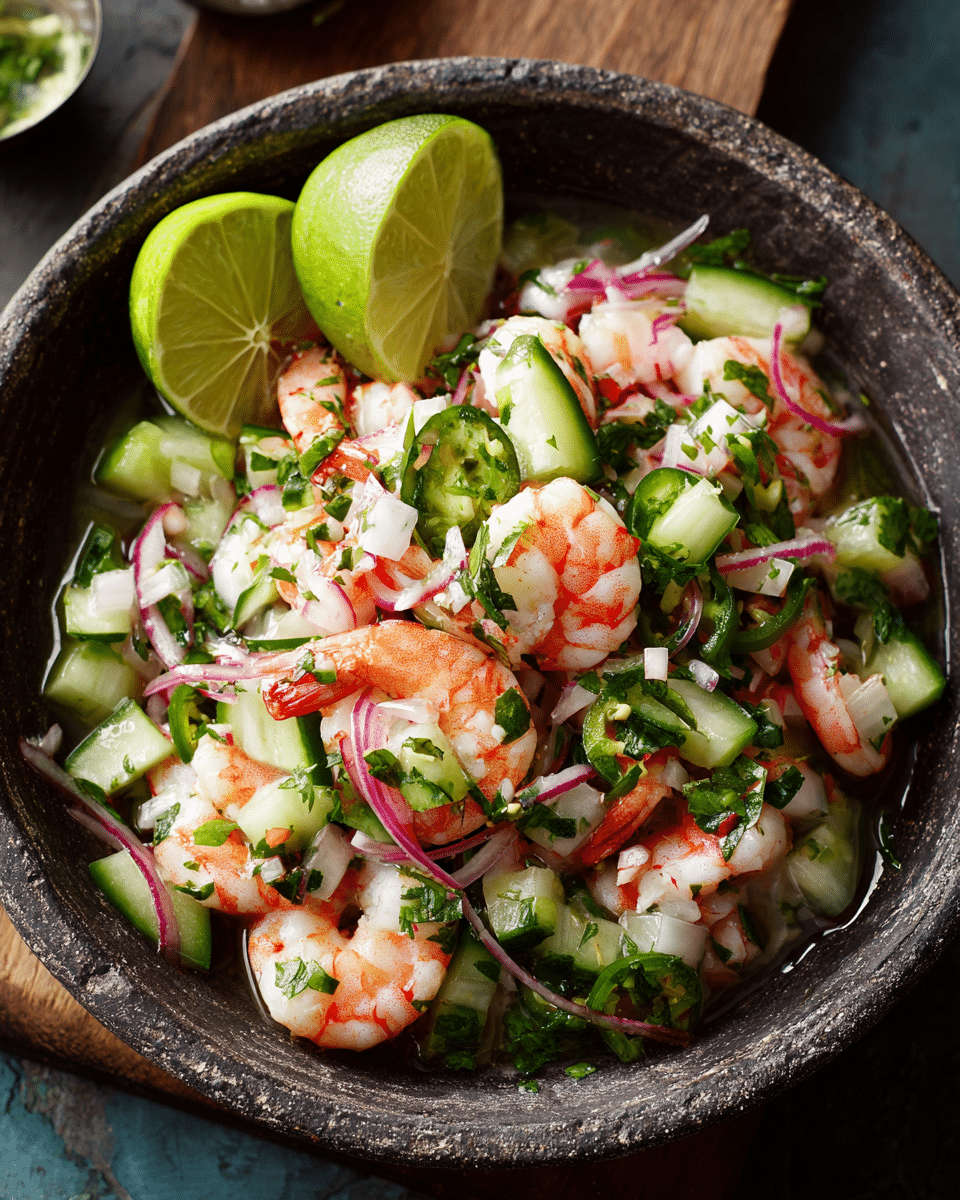Aguachile Shrimp with Lime is a vibrant and refreshing Mexican dish, perfect for celebrating Mexican Independence Day or any warm-weather gathering. This coastal specialty from Sinaloa features fresh shrimp “cooked” in tangy lime juice, then tossed with crisp vegetables, chilies, and fragrant cilantro.
FULL RECIPE
Ingredients
- 1 lb (450 g) raw shrimp, peeled, deveined, and butterflied
- 1 cup freshly squeezed lime juice (about 8–10 limes)
- 1–2 fresh serrano peppers, sliced (adjust to spice preference)
- 1 small red onion, thinly sliced
- 1 cucumber, peeled, seeded, and thinly sliced
- 1/2 cup fresh cilantro leaves, roughly chopped
- 1 clove garlic, minced (optional)
- Salt, to taste
- Freshly ground black pepper, to taste
- 1 avocado, sliced (for garnish, optional)
- Tortilla chips or tostadas, for serving
Directions
- Prepare the shrimp by butterflying them lengthwise and placing them in a glass or non-reactive bowl.
- Pour the lime juice over the shrimp, ensuring they are fully submerged. Cover and refrigerate for 20–30 minutes, or until the shrimp turn opaque and are “cooked” through by the citrus.
- While the shrimp marinate, slice the red onion, cucumber, and serrano peppers.
- Once the shrimp are ready, drain most of the lime juice, leaving about 2–3 tablespoons for flavor.
- Add the sliced onions, cucumber, serrano peppers, garlic (if using), and cilantro to the shrimp. Toss gently to combine.
- Season with salt and pepper to taste. Adjust lime juice or chili level if desired.
- Garnish with avocado slices before serving.
- Serve immediately with tortilla chips or tostadas for scooping.
Nutrition Facts
- Calories: 120
- Protein: 18 g
- Fat: 3 g
- Saturated Fat: 0.5 g
- Cholesterol: 125 mg
- Carbohydrates: 6 g
- Fiber: 2 g
- Sugars: 2 g
- Sodium: 320 mg
Cultural Origins of Aguachile Shrimp with Lime
Aguachile is deeply rooted in the culinary traditions of Sinaloa, a coastal state in northwestern Mexico. Its name translates to “chili water,” a reference to the spicy lime-chili marinade that forms the heart of the dish. Historically, it was made by fishermen who used freshly caught shrimp, lime juice, and local chilies to prepare a quick, flavorful meal without the need for cooking over heat. This method not only preserved the freshness of the seafood but also enhanced its natural sweetness. Over time, the recipe has evolved and spread throughout Mexico, with each region adding its own twist, making it a beloved appetizer for celebrations like Mexican Independence Day.
Flavor Profile and Sensory Experience
Aguachile Shrimp with Lime offers a dynamic sensory journey. The lime juice delivers a bold tang that “cooks” the shrimp, creating a firm yet tender bite. Serrano peppers or jalapeños introduce a sharp heat that lingers, while the cucumber adds cooling freshness to balance the spice. Red onions provide a subtle sweetness and crunch, while cilantro infuses an aromatic, herbal note. Together, these elements create a refreshing yet fiery dish that feels light on the palate but leaves a lasting impression of bold flavors and crisp textures.
Nutritional Benefits
Aguachile is naturally nutrient-dense and low in calories, making it an excellent choice for health-conscious diners. Shrimp is rich in lean protein, essential for muscle maintenance and repair, while also being low in fat. The lime juice contributes a significant dose of vitamin C, supporting immune health and skin vitality. Fresh vegetables like cucumber and onion provide dietary fiber, hydration, and additional vitamins. The minimal use of oil keeps the dish heart-friendly, and the natural flavors reduce the need for heavy seasoning, making it both nutritious and satisfying.
Role in Mexican Independence Day Celebrations
During Mexican Independence Day, food plays a central role in bringing people together, and Aguachile Shrimp with Lime is a perfect example of a celebratory dish that captures the essence of the holiday. Its bright colors mirror the vibrancy of the festivities, and its refreshing taste provides a welcome contrast to richer, heavier foods often served during gatherings. Because it is quick to prepare and served cold, it is ideal for outdoor parties or picnics, where guests can enjoy it alongside drinks, music, and dancing, making it a staple for modern holiday feasts.
Regional and Modern Variations
While the traditional recipe calls for raw shrimp, lime juice, chilies, and cucumber, regional variations abound. In coastal towns, it’s common to see aguachile made with scallops, octopus, or mixed seafood for a more complex flavor. Some cooks swap serrano peppers for habaneros to intensify the heat, while others add tropical fruits like mango or pineapple to create a sweet-spicy balance. Modern chefs have also experimented with infused oils, avocado purees, or even smoked salt to add depth to the flavor profile, proving that aguachile can be both traditional and innovative.
Serving Presentation Ideas
The beauty of Aguachile Shrimp with Lime lies in its presentation, which can be as rustic or refined as desired. For a casual gathering, it can be served in a large shallow platter surrounded by tostadas or tortilla chips for communal sharing. For a more upscale approach, individual portions can be presented in cocktail glasses or martini cups, garnished with avocado slices and microgreens for a polished look. Edible flowers, thin radish slices, or a drizzle of chili oil can add visual appeal, making it an Instagram-worthy centerpiece at any event.
Best Pairings with Drinks and Sides
Because of its bright acidity and spice, Aguachile pairs beautifully with refreshing beverages that help balance the heat. A crisp Mexican lager, light pilsner, or sparkling water with lime works wonderfully. For those who prefer cocktails, a classic margarita, michelada, or paloma complements the dish’s tanginess. On the side, it pairs well with simple accompaniments like guacamole, fresh salsa, or esquites (Mexican street corn salad). The key is to choose drinks and sides that refresh the palate and enhance, rather than overpower, the delicate shrimp flavor.
Tips for Controlling Spice Levels
The heat in Aguachile Shrimp with Lime can be easily adjusted to suit different spice tolerances. For a milder version, use fewer chilies, remove the seeds, or opt for jalapeños instead of serranos. To increase the heat, leave the seeds in or use spicier varieties like habaneros or chiltepin peppers. Another way to moderate spice is to balance it with more cucumber or avocado, which provide a cooling effect. Taste-testing the marinade before adding it to the shrimp can also help ensure the spice level is just right for your guests.
Storage and Make-Ahead Advice
Aguachile is best enjoyed fresh, as the shrimp continues to “cook” in the lime juice over time, which can make the texture overly firm if left too long. If you need to prepare in advance, marinate the shrimp for no more than 30 minutes, then store the shrimp and vegetables separately in the refrigerator. Assemble them just before serving to preserve the crispness of the vegetables and the tenderness of the shrimp. Leftovers should be consumed within 24 hours for the best taste and safety.
Health and Dietary Adaptations
This dish is naturally gluten-free and can easily be adapted for various dietary needs. For a keto-friendly version, serve the aguachile without tortilla chips, or substitute with lettuce cups for a low-carb alternative. Vegetarians or vegans can enjoy a similar flavor profile by replacing shrimp with hearts of palm, thinly sliced mushrooms, or young coconut meat, which mimic the texture of seafood when marinated in lime juice. Additionally, those watching their sodium intake can reduce or omit added salt, relying on herbs and citrus for flavor.
Conclusion
Aguachile Shrimp with Lime is more than just a refreshing seafood appetizer—it’s a celebration of Mexican coastal flavors and a testament to the beauty of simple, fresh ingredients. Perfect for hot days and festive gatherings, it offers a balance of tang, spice, and crisp textures that awaken the palate. Whether served in its traditional form or with creative modern twists, it embodies the spirit of sharing, tradition, and culinary creativity.






